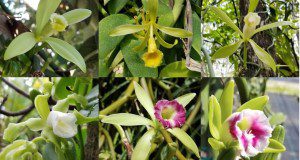L’extrait de vanille est populaire dans le monde entier comme ingrédient dans la crème glacée et divers autres desserts. La source botanique de l’extrait de vanille provient principalement des gousses durcies (préparées) de l’espèce Vanilla planifolia. Les États-Unis sont les plus grands importateurs mondiaux de gousses de vanille, mais la production nationale est très faible. Toutefois, le sud de la Floride a un potentiel de production favorable á la culture de la vanille. Ce document contient des informations utiles aux producteurs intéressés par l’établissement d’une vanillerie.
This is the French version of HS1348, Vanilla Cultivation in Southern Florida. This new 9-page publication was written by Alan Chambers, Pamela Moon, Vovener de Verlands Edmond, and Elias Bassil, translated by Francesca Carla Erié, and published by the UF/IFAS Horticultural Sciences Department.
https://edis.ifas.ufl.edu/hs1351
Tag: Alan H. Chambers
Vanilla Cultivation in Southern Florida
Vanilla extract is popular around the world as an ingredient in ice cream and various other desserts. The botanical source of vanilla extract is primarily the cured beans of Vanilla planifolia. The United States is the world’s largest importer of vanilla beans, but domestic production is minimal. However, southern Florida has a favorable growing environment for vanilla cultivation. This new 7-page publication of the UF/IFAS Horticultural Sciences Department includes information relevant to growers interested in establishing a vanillery. Written by Alan H. Chambers, Pamela Moon, Vovener de Verlands Edmond, and Elias Bassil.
https://edis.ifas.ufl.edu/hs1348
Alpine Strawberry as a Potential Niche Crop for Florida Growers and Homeowners
Alpine strawberries (Fragaria vesca) produce edible and highly aromatic strawberries known for their excellent eating quality. The berries are fragile and not suitable for long-distance shipping, which inhibits trade on the international market but also provides an opportunity for growers catering to local markets and for homeowners interested in growing this unique and delicious strawberry. This 5-page fact sheet written by Alan Chambers and published by the UF/IFAS Horticultural Sciences Department describes yield and fruit quality for several varieties to guide potential growers. The results of this project are anticipated to benefit growers and homeowners looking to cultivate specialty alpine strawberries.
http://edis.ifas.ufl.edu/hs1326

